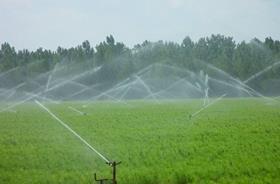
Farmers could be forced to scale-back irrigated potato production by more than a third if Environment Agency (EA) proposals on time-limited abstraction licences are implemented.
A major study by water experts at Cranfield University concluded that the EA’s plan to limit each abstraction licence to the average volume actually used between 2003 and 2009 will have a disproportionate impact on agriculture and fails to take into account how licences are used by farm businesses.
The study found that future abstraction licensing should recognise the importance and value attributed to groundwater for supporting agricultural and horticultural production - and the additional economic impacts generated for the rural economy and local employment.
The report, commissioned by the NFU, comes at a time when the EA is due to take decisions on how to make time-limited abstraction licences compliant with the requirements of European Union environmental rules contained in the Water Framework Directive.
NFU national water resources specialist Paul Hammett, said: “This is an important, comprehensive report that adds an agricultural context to proposed licensing changes. It provides a body of evidence to describe past weather patterns and their impact on water use and crop yield.
“It reinforces our view that alternative and smarter solutions must be found to the currently proposed simplistic solution of clawing back those licensed volumes of water that farmers currently hold in reserve for spells of dry weather.”
The Cranfield report addresses licensing issues in the Cam and Ely Ouse catchment in the East of England, where 50 surface water and 150 groundwater licences have just been renewed until 2018, pending a decision being taken on their longer-term status.
The major findings of the Cranfield report are that:
- While the impact of the proposed rules changes will be applied equally to public water supply, they will have a disproportionate impact on farmers. This is because time-limited licences account for over 90 per cent of agricultural water use but only one third of water company use (furthermore,water companies can spread their water need across different licences using different sources).
- The financial value of irrigation for potato and vegetable production in the Cam & Ely Ouse catchment is £91 million, of which £40m is attributed to groundwater and £51m to surface water.
- Reservoir storage is unlikely to offer a solution for farmers whose groundwater volumes are curtailed.
- Proposals to constrain irrigation to ‘recent actual’ base years is unfair because recent summers have been predominantly wet, meaning that farmers have needed to abstract less water than in dry years. The driest summer experienced during the period 2003 to 2009 was described as being merely an ‘average year’ when included in a much longer (30 years ) climatic time series running from 1960 to 2002.
- Reducing available irrigation water from the Environment Agency’s own existing ‘optimum water use guidelines’ to the average of actually used volumes during the 2003 to 2009 ‘base year’ period would reduce yield benefit by 26 per cent. Losses attributed to product quality would be additional and substantial but are difficult to quantify
- Farmers who respond to the risk of reduced licensed water availability by reducing irrigated crop production would need to scale back their area of potatoes by 39 per cent.
- But spray irrigation licences are not typically used every year (because of rainfall) and the EA’s licence proposals fail to take account of farmers’ intermittent need for water. This omission could have profound unintended impacts on irrigation water use and the economic benefits derived from irrigated production in the catchment. When accounting for ‘intermittent use’, potato yields are forecast to decline by 47 per cent.



